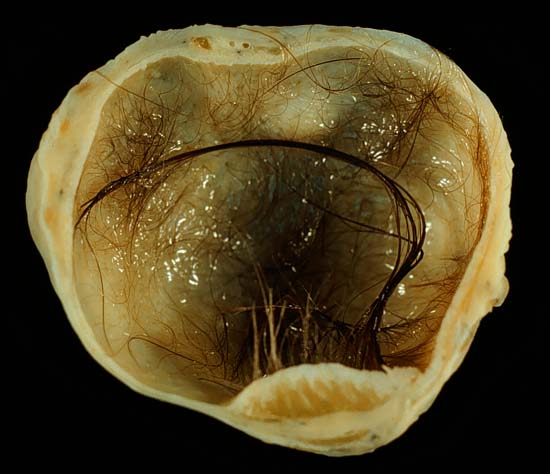 Anatomy Lesson of Dr. Tulip, Rembrandt (1632)I have been extremely ill this week which has prevented me from posting as often as I would have liked. However, I have been keeping up on the suggestions offered to explain the nearly 300-year-old medical mystery involving "hairy crustaceous substances" voided in a woman's urine. Of all the potential explanations for this phenomenon I think Quinn O. nailed it with his diagnosis of pilimiction as the result of a dermoid tumor. In doing a little research on this condition I discovered that this is caused when an abnormal growth develops that contains fully grown hairs, skin cells, sweat glands, even teeth or pieces of bone (see picture below). These usually develop in the ovaries and, in rare cases, they invade the bladder where the material is leaked into the urinary tract.
Anatomy Lesson of Dr. Tulip, Rembrandt (1632)I have been extremely ill this week which has prevented me from posting as often as I would have liked. However, I have been keeping up on the suggestions offered to explain the nearly 300-year-old medical mystery involving "hairy crustaceous substances" voided in a woman's urine. Of all the potential explanations for this phenomenon I think Quinn O. nailed it with his diagnosis of pilimiction as the result of a dermoid tumor. In doing a little research on this condition I discovered that this is caused when an abnormal growth develops that contains fully grown hairs, skin cells, sweat glands, even teeth or pieces of bone (see picture below). These usually develop in the ovaries and, in rare cases, they invade the bladder where the material is leaked into the urinary tract.
A case study in the Medico-Chirurgical Review and Journal of Practical Medicine from 1828 described pilimiction in a 25-year-old woman:
After some time, her husband (in the presence of M. Delpech) extracted from the patient's bladder, by means of an instrument, a mass of hair, of considerable size. Several other extractions were subsequently performed. But, at length, she came into the hospital of Montpellier, and M. Delpech, having first dilated the urethra, was enabled to reach the bladder with his finger, and extract a large ball of hair. The patient continued well for two years, at which period, she evinced symptoms of stone in the bladder, and M. Delpech removed a calculus, the size of an egg, the nucleus of which was a piece of skin, covered with hair, and containing a portion of zigomatic bone ! M. Delpech explains this case, by supposing that the debris of an imperfect fetus had made its way through the parietes of the uterus or ovaria into the bladder ; and, indeed, we cannot see any other rational explanation of the phenomenon.

A mature dermoid cyst that contains functioning hair follicles.
These cysts can invade the bladder resulting in hairs appearing in the urine.
Image: Ed Uthman, MD. Wikimedia Commons
A later description from the British Medical Journal in 1916 presents the condition in much the same way it's understood today:
Pilimiction, or the passage of true hairs in the urine, is a phenomenon of very rare occurrence. It was noted by Hippocrates in his Aphorisms, with the erroneous explanation that the hairs were excreted by the kidneys. Galen and many medical writers after his day referred to pilimiction, often adding strange hypotheses or theories to account for the production of the hairs passed. It was not until 1849 that the true explanation was given, by the French surgeon Reyer. He found that the hairs originated in dermoid cysts, and reached the urine by the rupture of such cysts into the bladder. Naturally the other contents of the cysts would enter the bladder, so that teeth, carious teeth, bones, and fragments of other tissues might be found in it ; but these do not seem, as a rule, to be passed in the urine by the patients to whom this unusual accident has occurred.
Here's a few modern case studies (#1, #2 and #3) that refer to the phenomenon in much the same way.
In the original case study from 1733 the royal physician Sir Hans Sloane stated confidently that:
I have considered, and am satisfied, that the hairy Excretions are generated most likely in her Kidneys.
It would actually seem most likely that Sloane was merely regurgitating ancient medical dogma in his assumption that the condition originated in the kidneys. As I highlighted in my earlier post, The Grassroots of Scientific Revolution, doing direct dissections and experimentation was considered secondary to studying these ancient texts throughout most of medical history. Even well into the nineteenth century, physicians often referred to the ancients for their diagnoses about modern medical problems.
Many thanks to Quinn O. for pointing us to what may be the correct diagnosis. There is, of course, always doubt when diagnosing a case study from so long ago since the way physicians in the past described the characteristics may not be the same as today. However, given that there is such similarity between 1733, 1828, and today in its description I think it's pretty safe to view them as the same condition.

It was very important to study human anatomy. Without that medical information would have impossible to give to sick people. Medical science had progressed through this study. Hope you get well.
Thank you for the interesting challenge, Eric. I hope you feel better soon.